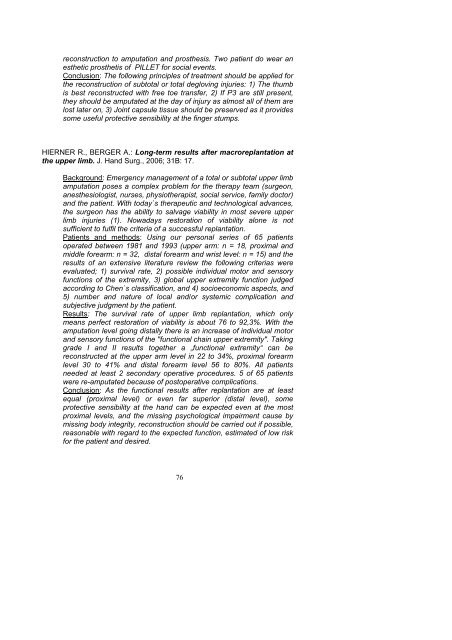2006 - UZ Leuven
2006 - UZ Leuven
2006 - UZ Leuven
Create successful ePaper yourself
Turn your PDF publications into a flip-book with our unique Google optimized e-Paper software.
econstruction to amputation and prosthesis. Two patient do wear anesthetic prosthetis of PILLET for social events.Conclusion: The following principles of treatment should be applied forthe reconstruction of subtotal or total degloving injuries: 1) The thumbis best reconstructed with free toe transfer, 2) If P3 are still present,they should be amputated at the day of injury as almost all of them arelost later on, 3) Joint capsule tissue should be preserved as it providessome useful protective sensibility at the finger stumps.HIERNER R., BERGER A.: Long-term results after macroreplantation atthe upper limb. J. Hand Surg., <strong>2006</strong>; 31B: 17.Background: Emergency management of a total or subtotal upper limbamputation poses a complex problem for the therapy team (surgeon,anesthesiologist, nurses, physiotherapist, social service, family doctor)and the patient. With today`s therapeutic and technological advances,the surgeon has the ability to salvage viability in most severe upperlimb injuries (1). Nowadays restoration of viability alone is notsufficient to fulfil the criteria of a successful replantation.Patients and methods: Using our personal series of 65 patientsoperated between 1981 and 1993 (upper arm: n = 18, proximal andmiddle forearm: n = 32, distal forearm and wrist level: n = 15) and theresults of an extensive literature review the following criterias wereevaluated; 1) survival rate, 2) possible individual motor and sensoryfunctions of the extremity, 3) global upper extremity function judgedaccording to Chen`s classification, and 4) socioeconomic aspects, and5) number and nature of local and/or systemic complication andsubjective judgment by the patient.Results: The survival rate of upper limb replantation, which onlymeans perfect restoration of viability is about 76 to 92,3%. With theamputation level going distally there is an increase of individual motorand sensory functions of the "functional chain upper extremity". Takinggrade I and II results together a „functional extremity“ can bereconstructed at the upper arm level in 22 to 34%, proximal forearmlevel 30 to 41% and distal forearm level 56 to 80%. All patientsneeded at least 2 secondary operative procedures. 5 of 65 patientswere re-amputated because of postoperative complications.Conclusion: As the functional results after replantation are at leastequal (proximal level) or even far superior (distal level), someprotective sensibility at the hand can be expected even at the mostproximal levels, and the missing psychological impairment cause bymissing body integrity, reconstruction should be carried out if possible,reasonable with regard to the expected function, estimated of low riskfor the patient and desired.76

















